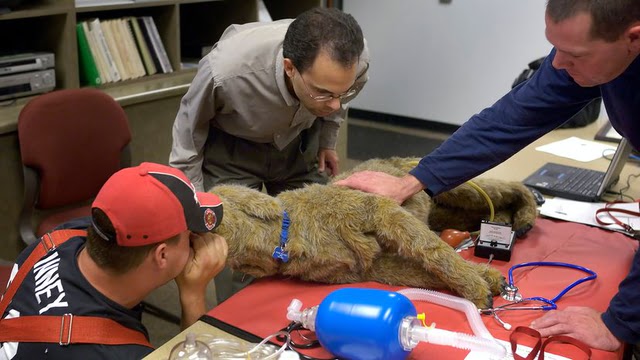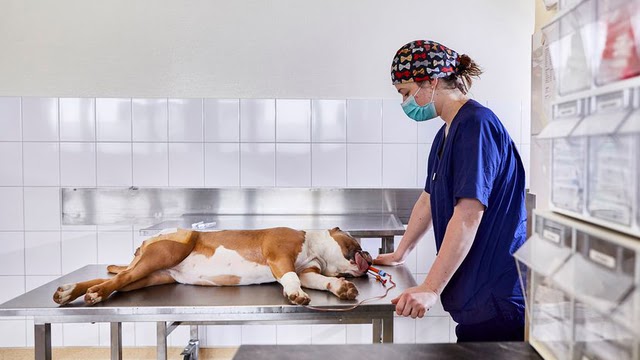Quck answer
Giving your dog CPR can save their life in an emergency situation. First, lay your dog on their right side on a flat surface. Check for a pulse by placing your hand on their chest, just behind their elbow. If there is no pulse, begin chest compressions by pressing down on their chest with both hands, just behind their elbow. Give two breaths by closing your dog’s mouth and breathing into their nose. Repeat the cycle of chest compressions and breaths until you feel a pulse or until you reach a veterinary clinic. Always consult with a veterinarian to ensure you are performing CPR correctly.
Pets

Veterinarian Dr. Mike Estrin (center) is seen instructing two New Brighton, Minnesota, firefighters on how to perform CPR on a dog using a CPR-practice dog. One is simulating mouth-to-snout breathing while the other is checking for lungs filling with air. Star Tribune via Getty Images/Getty Images
It was my worst nightmare: My cherished 13-year-old English bulldog, Ellie, collapsed one morning following our usual walk. She relieved herself as usual, but on our way back home, she stopped at the welcome mat and fainted. It seemed like an eternity before she regained consciousness.
When she came to, she was wheezing and struggling to breathe. That’s when I instinctually sprang into action.
Even though I had no idea how to conduct cardio pulmonary resuscitation (CPR) on a dog, I had witnessed it being performed on humans, so I began pressing on her chest, slapping her face, and even giving her mouth-to-mouth resuscitation as best as I could. I then placed her in the car and rushed to the vet, who immediately provided her with oxygen and an IV. The next day, the vet informed me that my actions had “saved her bacon.”
Since then, Ellie has been diagnosed with a condition that can sometimes cause her heart to stop. So, I made a vow to learn the correct way to execute CPR on a dog, just in case it happens again. Here’s what I discovered from various experts on the topic.
How to Tell If Your Dog Requires CPR
Dr. Rebecca Greenstein, a veterinary medical adviser for Rover.com and the chief veterinarian of Ontario’s Kleinburg Veterinary Hospital, advises that you should seek immediate veterinary attention and start CPR if your pet is manifesting any of the following symptoms:
- They’re unresponsive or unconscious
- They’re not breathing (you can’t see their chest rising or falling or moving at all)
- You don’t feel a pulse or heartbeat. (You’ll feel it on the left side of their chest, close to where their flexed elbow would meet their chest wall.)
“The objective,” according to Dr. Travis Arndt, director of the Animal Medical Center of Mid-America in St. Louis, Missouri, “is to keep oxygen flowing to the vital organs until the heartbeat and breathing are restored.”
How to Conduct CPR on Your Dog
“Basic CPR is as simple as A-B-C: Airway-Breathing-Circulation,” explains Greenstein. She also notes that in cases where a dog has gone into cardiac arrest (rather than one that is known to have heart disease), it might be wise to begin with chest compressions first. However, the typical A-B-C order is fine as long as you commence all CPR components fairly quickly and if no other alternatives or resources are available.
She breaks down the steps she takes to administer CPR to a dog:
A: Airway
- Place your dog on their right side so that the left side of their body is facing upward.
- Ensure that the surface underneath is firm and clear of any hazards or debris.
- Use your index finger to remove any foreign bodies or fluids that may obstruct their airway from the back of their throat. (Do not overextend their neck.)
- Pull the dog’s tongue forward to their front teeth so that it does not fold back into their throat and obstruct their airway.
B: Breathing
The first step to perform CPR on a dog is to close his mouth and breathe into his nostrils to inflate his lungs. The mouth-to-snout breathing technique requires exhaling forcefully enough into the nostrils to see the dog’s chest rise. After this, the dog should exhale passively before repeating the process. Typically, one should aim for 10 breaths per minute. However, if the chest compressions are being performed simultaneously, two breaths should be administered after every 30 chest compressions. Chest compressions simulate a heartbeat that helps pump the dog’s blood around the body when the heart has stopped. For medium and large dogs, chest compressions should be administered with the dog lying on his side. In contrast, smaller dogs require the circumferential method, where hands are placed around the chest and back, allowing the thumbs to meet at the dog’s sternum. Barrel-chested dogs should be placed on their backs, and both hands should be used to perform compressions on the front of the chest. Dog CPR’s effectiveness varies, with less than 10% of patients surviving the efforts. Around 35% of pets that experience cardiac or respiratory arrest have another episode of arresting. The faster an arrest is recognized and CPR initiated, the more likely there will be a positive outcome. During CPR classes, dozens of students have reported successfully performing doggy or kitty CPR.
Are There Any Risks Involved in Performing CPR on a Dog?
According to Denise Fleck, founder of Sunny-dog Ink, there are no risks involved in performing CPR on your pet. She explains that if you need to perform CPR, it means that your pet is already “dead,” so attempting to resuscitate them poses no additional risks. However, it’s important to be aware of potential issues that may arise if you perform CPR outside of a veterinary hospital. Overzealous chest compressions, for example, can lead to rib fractures, lung bruises or lacerations, air in the chest and collapsed lungs. Other overlooked risks include tracheal bleeding, ineffective CPR efforts, and delayed professional medical help.
Fleck also notes that the biggest concern pet owners have is breaking their pet’s ribs. However, dogs have more flexible ribs than humans, so the chances of a rib fracture are very low (less than 1.6 percent) if CPR is performed correctly. When performing CPR on small animals, it’s crucial to give smaller breaths to avoid over-inflating the lungs, which can hinder recovery.

After performing CPR, it’s important to take your pet to the veterinarian immediately, even if they seem to have recovered. According to Dr. Sara Ochoa, a veterinary consultant for DogLab.com, it’s possible for dogs to crash again and require more CPR. A veterinarian is better equipped to provide life support and necessary treatments in case of a relapse. Dr. Jennifer Coates, an advisory board member of Pet Life Today, also stresses the importance of seeking additional treatment and diagnostics, even if CPR is initially successful.
Dr. Greenstein recommends that every dog owner learn small animal CPR and consult their veterinarian on emergency procedures. The American Red Cross offers pet CPR classes as part of their Cat and Dog First Aid course, which can help pet owners prepare for emergency situations.
What Should I Do After Performing CPR on My Dog?
In contrast to humans receiving CPR, pets won’t have an ambulance and paramedics available to take over. Therefore, pet owners should take their pet to the veterinarian themselves, as soon as possible. It’s essential to seek professional medical help, as advanced CPR can only be performed by a skilled veterinary team.
FAQ
1. What is CPR?
CPR stands for cardiopulmonary resuscitation. It is a lifesaving technique used to revive individuals who have stopped breathing or whose heart has stopped beating. CPR involves chest compressions, rescue breaths, and other life-saving measures.
2. Can you perform CPR on a dog?
Yes, you can perform CPR on a dog. The technique is similar to that used on humans but with some modifications to account for the anatomical differences between dogs and humans.
3. When should I perform CPR on my dog?
You should perform CPR on your dog if they are not breathing, have no pulse, or are unresponsive. This could be due to drowning, choking, electrocution, or other accidents.
4. How do I know if my dog needs CPR?
If your dog is not breathing, has no pulse, or is unresponsive, they may need CPR. You can check for a pulse by placing two fingers on the inside of their thigh, near the groin area. You can also check for breathing by observing their chest for movement or feeling for breaths on your hand placed near their nose or mouth.
5. How do I perform CPR on my dog?
To perform CPR on your dog, lay them on their right side and perform chest compressions by applying firm pressure to the chest area. You should also give rescue breaths by sealing your mouth over their nose and mouth and blowing air into their lungs. Repeat these steps until your dog starts breathing on their own or until you can get them to a veterinarian.
6. How many chest compressions should I give my dog?
You should give your dog 100-120 chest compressions per minute. The compressions should be firm and deep, going about one-third to one-half the depth of the chest.
7. How many rescue breaths should I give my dog?
You should give your dog 2-3 rescue breaths after every 30 chest compressions. The rescue breaths should be enough to make the chest rise.
8. Is it safe to perform CPR on my dog?
Performing CPR on your dog can be safe if done correctly. However, it is important to take precautions to avoid injury to your dog or yourself.
9. Should I give my dog anything to stimulate their heart during CPR?
No, you should not give your dog anything to stimulate their heart during CPR. It is best to focus on chest compressions and rescue breaths.
10. Can CPR save my dog’s life?
CPR can increase your dog’s chances of survival if performed correctly and promptly. However, it is still important to seek veterinary care as soon as possible after performing CPR.
11. What should I do if my dog starts breathing on their own during CPR?
If your dog starts breathing on their own during CPR, stop performing chest compressions and continue to give rescue breaths until they are fully conscious and breathing normally.
12. What should I do if my dog does not respond to CPR?
If your dog does not respond to CPR, seek veterinary care immediately. Even if CPR is not successful, it is important to get your dog to a veterinarian as soon as possible to assess their condition.





Leave a Reply